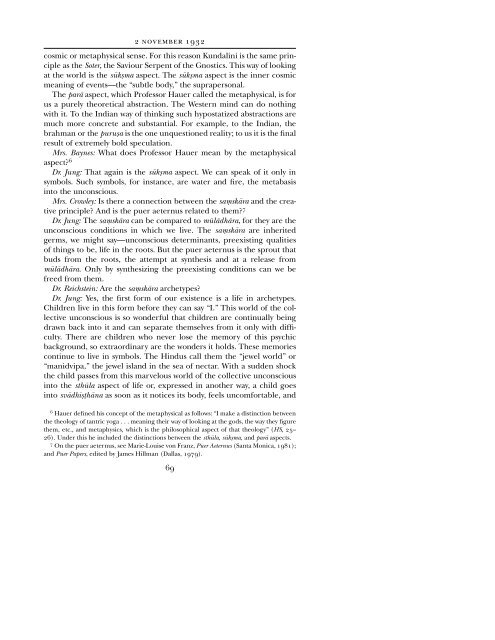CG JUNG - Countryside Anarchist
CG JUNG - Countryside Anarchist
CG JUNG - Countryside Anarchist
You also want an ePaper? Increase the reach of your titles
YUMPU automatically turns print PDFs into web optimized ePapers that Google loves.
2 NOVEMBER 1932<br />
cosmic or metaphysical sense. For this reason Kundalini is the same principle<br />
as the Soter, the Saviour Serpent of the Gnostics. This way of looking<br />
at the world is the sÖküma aspect. The sÖküma aspect is the inner cosmic<br />
meaning of events—the “subtle body,” the suprapersonal.<br />
The parv aspect, which Professor Hauer called the metaphysical, is for<br />
us a purely theoretical abstraction. The Western mind can do nothing<br />
with it. To the Indian way of thinking such hypostatized abstractions are<br />
much more concrete and substantial. For example, to the Indian, the<br />
brahman or the puruüa is the one unquestioned reality; to us it is the final<br />
result of extremely bold speculation.<br />
Mrs. Baynes: What does Professor Hauer mean by the metaphysical<br />
aspect? 6<br />
Dr. Jung: That again is the sÖküma aspect. We can speak of it only in<br />
symbols. Such symbols, for instance, are water and fire, the metabasis<br />
into the unconscious.<br />
Mrs. Crowley: Is there a connection between the saôskvra and the creative<br />
principle? And is the puer aeternus related to them? 7<br />
Dr. Jung: The saôskvra can be compared to mÖlvdhvra, for they are the<br />
unconscious conditions in which we live. The saôskvra are inherited<br />
germs, we might say—unconscious determinants, preexisting qualities<br />
of things to be, life in the roots. But the puer aeternus is the sprout that<br />
buds from the roots, the attempt at synthesis and at a release from<br />
mÖlvdhvra. Only by synthesizing the preexisting conditions can we be<br />
freed from them.<br />
Dr. Reichstein: Are the saôskvra archetypes?<br />
Dr. Jung: Yes, the first form of our existence is a life in archetypes.<br />
Children live in this form before they can say “I.” This world of the collective<br />
unconscious is so wonderful that children are continually being<br />
drawn back into it and can separate themselves from it only with difficulty.<br />
There are children who never lose the memory of this psychic<br />
background, so extraordinary are the wonders it holds. These memories<br />
continue to live in symbols. The Hindus call them the “jewel world” or<br />
“manidvipa,” the jewel island in the sea of nectar. With a sudden shock<br />
the child passes from this marvelous world of the collective unconscious<br />
into the sthÖla aspect of life or, expressed in another way, a child goes<br />
into svvdhiü°hvna as soon as it notices its body, feels uncomfortable, and<br />
6 Hauer defined his concept of the metaphysical as follows: “I make a distinction between<br />
the theology of tantric yoga . . . meaning their way of looking at the gods, the way they figure<br />
them, etc., and metaphysics, which is the philosophical aspect of that theology” (HS, 25–<br />
26). Under this he included the distinctions between the sthÖla, sÖküma, andparv aspects.<br />
7 On the puer aeternus, see Marie-Louise von Franz, Puer Aeternus (Santa Monica, 1981);<br />
and Puer Papers, edited by James Hillman (Dallas, 1979).<br />
69


